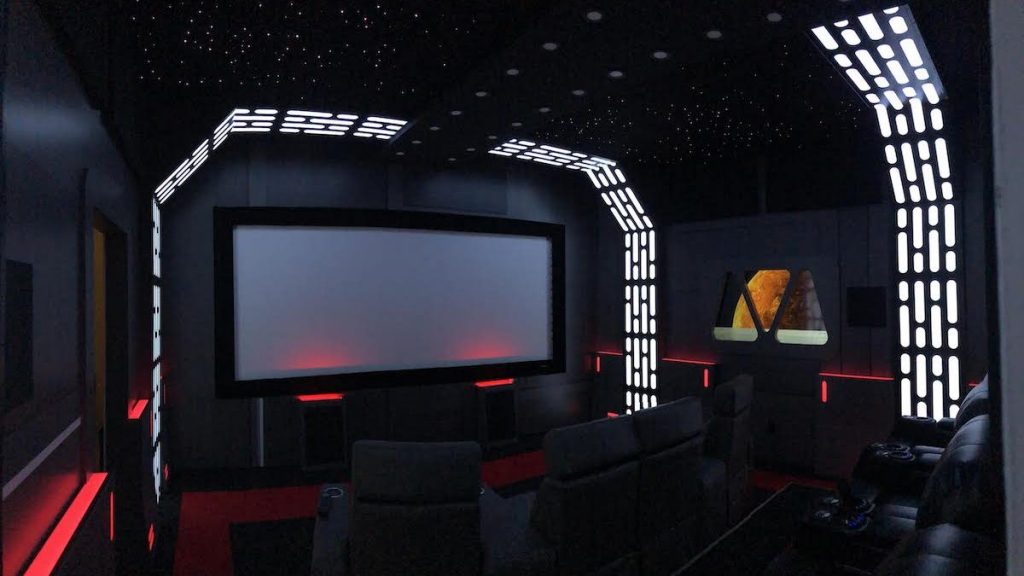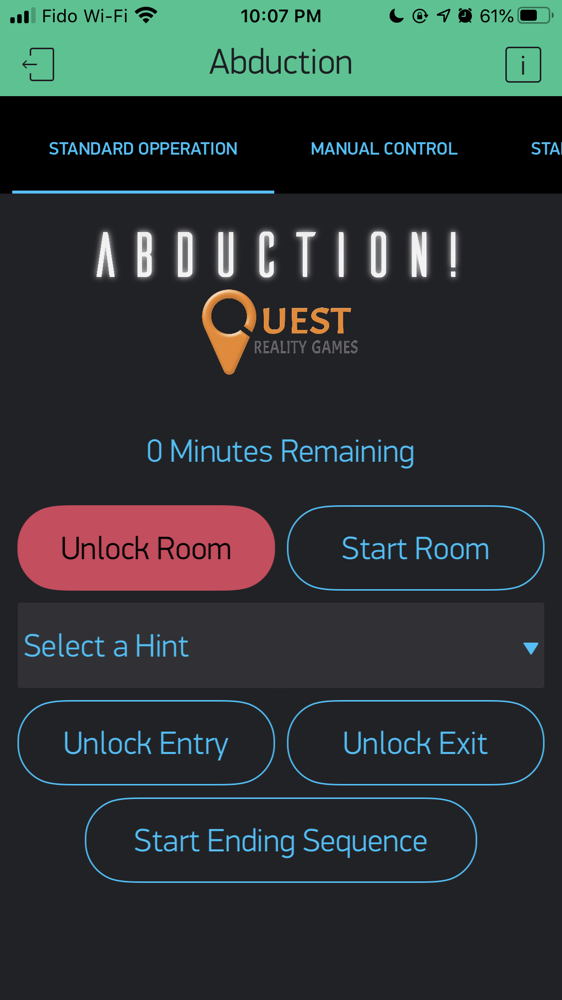NOTE: specific details have been omitted to protect the confidentiality of the Abduction! experience
In January 2020, the team at Encompass was commissioned to design and implement an escape room experience. Even though we had experience with interactive experiences through the simulation industry, we had never performed this type of project before.
The introduction to this project stemmed from the Star Wars theatre project for OneTouch House. The client, Quest Reality Games, was also a client of theirs and saw the theatre. They were renovating one of their existing experiences and wanted a sci-fi themed room.

During the planning and design phase of this project, we had to overcome three main challenges in order to provide a different type of approach to the escape games industry.
As entertaining and immersive most escape games are, the industry as a whole suffers from one fatal flaw: you can’t play the same escape game twice. Well, you can, but just like watching a movie twice, you already know what happens. Since the premise is to solve a puzzle, it’s difficult to replicate that experience of solving the puzzle once the puzzle has been solved.
Because of this, escape room operators would regularly have to update their rooms and, in most cases, have to completely redo the room once the return on investment started to decline. Although situated in a tourist hotspot, having no new experiences to advertise meant that off-peak business would decline.
Our goal was to create a dynamic escape experience that was primarily software-driven. This meant that puzzles could be altered in development cycles, the storyline could be modified depending on trends, and each time a user played, they could get a different experience.
When deciding how the puzzles were going to be structured and what we were going to use to create them, we had three main options:
To achieve a balance between replayability and realism, we decided to implement option three. Our puzzles used Particle Argon micro-controllers interfaced with physical hardware connected to each other via an internal UDP network.
Each puzzle has a physical element to incorporate it into gameplay - physical buttons, rotating dials, RFID readers, and relays for locks.
The game is controlled by a central PC that runs the core game experience - a game built in Unity that outputs to three displays throughout the room. The PC and the Particle boards communicate back and forth via UDP stream so each puzzle knows what state the game is in at any given time during the experience.
This allows the puzzles to trigger lighting sequences, launch sound effects, unlock doors, and generally move the experience along.
Because the core gameplay is managed via software and each is puzzle is independently programmed but integrated to the overall experience, new features and experience adjustments can be added to expand and alter gameplay - the entire game can also be changed to something completely different while still using the existing hardware components.
In the future, should the need to adapt the experience to a different theme (christmas, halloween etc), it can be done without removing or changing any of the current hardware. This makes the single room replayable several more times before the user has exhausted all variations.
Most conventional escape games that involve locks, physical puzzles, objects of interest etc. require the game to be reset between experiences. This is not only time consuming and involves allowing enough time between plays for resets, thereby decreasing the potential throughput of the game, it also creates the potential for inaccurate resets. An inaccurate reset means that puzzles may not be reset properly, objects required for gameplay are not placed in the correct spot or doors are left unlocked. This diminishes the experience for the next group.
Most escape room operators also require active monitoring of the experience to ensure that the players are directed through the game via hints or prevent damage to the room via mishandling of irrelevant items in the room. Generally, hints are requested via a walkie-talkie radio and the game master would ask a series of follow up questions in order to get an understanding of where the players are stuck.
Aside from labour costs attributed to the monitoring of the game, it also pulls the players out of the experience in order to talk to a game master via radio.
Our challenge was to reduce the amount of overall labour required to actively monitor and reset the room, thereby reducing direct labour costs and increasing profit-per-game.
To overcome this challenge, we implemented:
As the experience is story-driven, we hired a voice actor to play the “character” and provide a narrative through the game. As part of the script, we also recorded hints in order to weave the narrative into the hint system and keep the players immersed in the gameplay. The hints would fire on a time-based trigger system that checked for:
The hints could also be requested manually through a communication device (a touch screen on the wall) that simulated the interstellar communication process and did not take the players out of the experience. The game masters would receive a notification that a hint was needed and could launch the hints via the game remote (an iPod touch running a custom app the controls the room).

As the game is largely software-based, resetting the game back to zero is a simple process that requires a few steps. The game masters have to replace a few key items that are easy to remember and locate. Once the items are in place, they press the RESET button on the game remote, which returns the game back to the idle mode awaiting the start command. Doors and puzzles can be locked/unlocked with a few taps from the remote and an active status is displayed on the remote so the game masters know if many of the puzzles are in the correct state.

Once the game has been reset and the new players loaded, the game runs a pre-start check to ensure that all doors are locked, all puzzles are in the correct state etc before allowing the game to be started. If any of the pre-start conditions are not met, the game masters are notified and a list of what needs to be corrected is provided. This ensures that the experience is consistent for every player group.
Although a more widespread practice among escape rooms, the need for an immersive, story-driven narrative is key to an optimal experience for players. Before loading players into the game, they are given a briefing on the experience and how they ended up in the situation. Once inside, the game is started by a character coming over the “radio” (a series of speakers placed throughout the room) and kicks off the experience any providing some background and creating a dramatic effect. This was accomplished by hiring a voice actor, specifically sourced due to their credentials in the video game industry, to provide the basis for the character.
Throughout the game, the character returns to add to the story and continue to keep the players immersed in the experience.
Another key component to the dynamic elements of the game is the time-based progress of the experience. As the players progress through the game, there are processes going on behind the scenes that change how the game is played over time. For example, if the players arrive at a specific puzzle 15 minutes into the experience, the combination to solve a puzzle will be different compared to a group arriving at the same puzzle 45 minutes into the experience. The dynamic element of the game allows players to have differing experiences from one another, despite the fact that the core gameplay is the same.
This process is also woven into the story to create a seamless experience for the players while preventing the game from appearing static and linear.
As the experience was created from the ground up, the game also included puzzles made with custom designed and manufactured parts. With a background in parts design and manufacturing, we leveraged Encompass Co-Founder, Stuart Bryson’s, expertise to design, develop, and install all of the various physical components.
This included custom lighting fixtures, control panels, touch screen enclosures, and entire puzzles. The parts were made out of MDF, 3D-printed plastic, and aluminum. We acquired a 3D printer for the project and all of the physical components were assembled onsite by Encompass.
Each part was designed to fit the aesthetic of the room and also be relatively easily replaceable in the event of failure or damage.
Lighting, sound, and visual effects are arguably the most important elements in creating a compelling experience. The room is filled with ambient lighting that changes depending on triggers provided by the game. Lighting effects are also used as part of gameplay and incorporated into puzzles.
Screens and projectors also provide the visual elements which incorporate information required to solve puzzles as well as aesthetic appeal. Speakers placed throughout the various rooms in the experience evenly distributed sound effects, and cinematic animations and interactive elements were fired at various points through the game.
This was arguably the most enjoyable part of developing the experience and has received the most amount of positive feedback from players.
Overall, the Abduction! escape room experience was a challenging and extremely rewarding project that spanned several months of design, planning, storytelling, programming, and installation. It was arguably the most complex project that Encompass has undertaken, and the most challenging project I’ve managed and been involved in during my career. It incorporated every single aspect of my skillset from:
Abduction! is located at Quest Reality Games
1211 Wharf St, Victoria BC V8W 1T9
250-800-1008
To check out Abduction! for yourself, click here